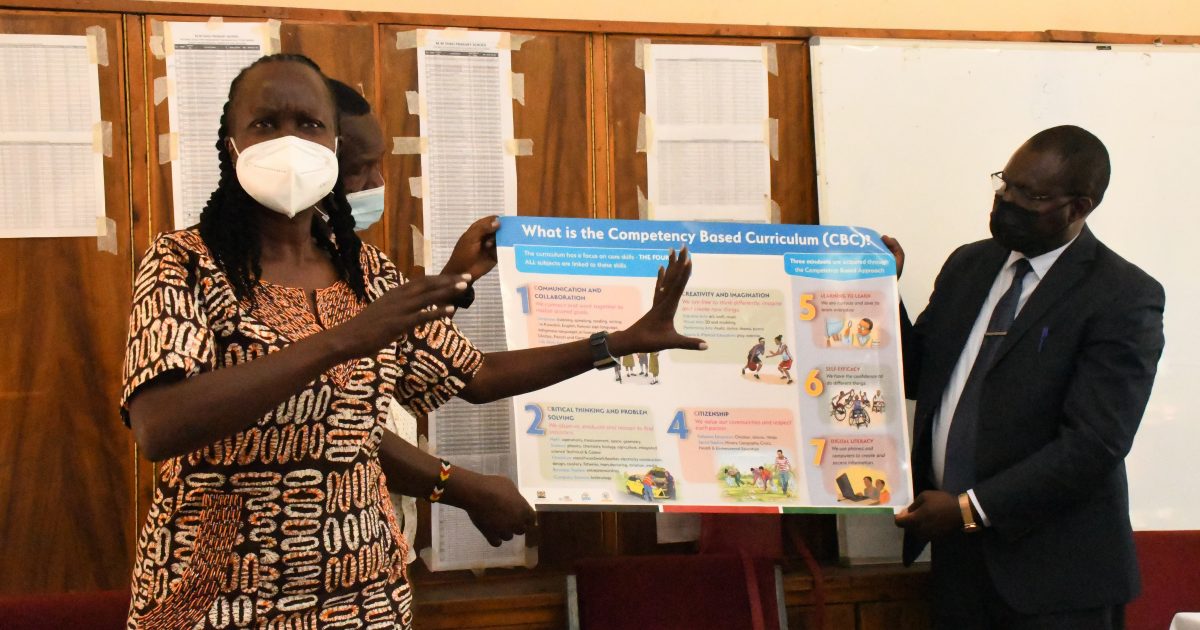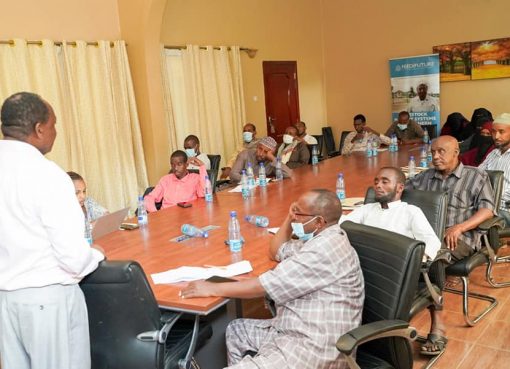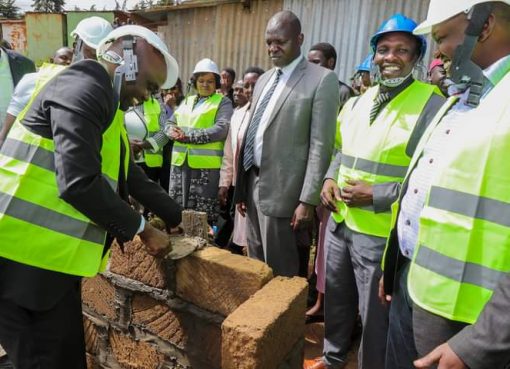It was on early Tuesday Morning at 8am when the MM Shah primary school early grade learners in Kisumu County had a special guest. The guest sat at the back of the class and listened keenly partaking too the lesson the children were being taught.
This was a mathematics lesson and the pupils had to add a three-digit number to one digit number by breaking apart.
For example, you want to add 127 to 6. Then you make the last digit of the three-digit number to become 10. In this case the pupils convert 7 to 10 and to do this they break 6 by counting forward from seven to ten. Thus (127+3) + 3 and that way it is made easier to add 130 +3= 133 as opposed to 127 +6.
This is a new strategy that the teachers had been trained on under the School Based Teacher Support (SBTS) project, to enable teachers simplify and make mathematics visible for lower class learners. This lesson had been identified by teachers in the early grades as a problem for the learners to grasp.
The special guest was Chief Administrative Secretary (CAS) for Curriculum Implementation, Dr. Sarah Rutto.School Based Teacher Support (SBTS) project funded by Global Partnership in Education through World Bank has changed the mindset that Mathematics is a difficult subject, by making the concept visible to the little learners in the early grades.
“Sometimes mathematics is made difficult because of its abstractness and so when you simplify it and make it visible, it becomes easy for the children to get the concept and the foundation that is required,” Dr. Rutto said.
She noted that Mathematics was a vital subject not only for the child but also for the Competency Based Curriculum when looking at the early years of education from PP1 to Grade 3 that emphasizes on children having strong competencies in literacy, numeracy and life skills.
She said that the project under Primary Education Development (PRIEDE) is intended to strengthen mathematics in Kenya. The project has four components for empowering the teachers, namely peer lesson observation, lesson study, action research and virtual learning community.
These key components allow the teachers to interact with one another, get feedback, collaborate and seek help among themselves. “So this project is giving teachers skills, retooling them, strengthening how teachers teach and how learning happens so that the children have a good foundation,” she said.
Under Peer lesson study, a teacher prepares a lesson and invites other teachers to observe and give feedback. In the lessons, study the teachers in a school or cluster, identify a mathematical problem, plan the lesson together, collect the material needed to execute the problem and then allow one teacher to teach as the other teachers involved in the planning observe to find out if the objective was achieved.
Action research involves researching on a problem within the class or cluster that affects learning for instance absenteeism or lack of participation and find solutions to the same, while virtual learning community allows teachers to form virtual groups to connect and collaborate with each other within the group and beyond.
“The impact of good foundation in Mathematics cannot be underestimated because if you want a person who will do well in all other areas it starts with person who has the grasp in the base in the subtraction, addition, multiplication and division and this is what the project is addressing,” CAS Rutto said.
She observed that some of the weak areas they found out when the children were being assessed in national examinations both at primary and secondary level, were Mathematics and English. “I am therefore confident that in a few years to come, we will see remarkable improvement in this area since the children will have had a good foundation,” she said.
Mr Joseph Kuria, a National Trainer in Early Grade Mathematic and SBTS Component under PRIEDE, said the aim of the project was to enhance teaching competencies for teachers in early years so that they could help learners to grow in mathematics.
“We designed content that teachers were trained on and developed content for early grade mathematics. We then trained master trainers, then the Curriculum Support Officers (CSO) and champion teachers. The trained staff was to cascade the information to the teachers in the classroom,” Mr Kuria said.
Mr Kuria said a number of activities were introduced in to be conducted within the school and others within the cluster as a way of sustaining the SBTS. The CSOs were to support teachers in their respective areas of jurisdiction.
“This was done through peer lesson observation in which a teacher prepares a lesson and invites others teachers to observe and give feedback. A teacher may be good and the other will learn from him or her. The lesson and feedback helps both the teacher who invited others and those who observed thus helping them to grow,” he said.
He said in doing so, the teachers understand the content better, learn to give feedback to each other and improve their professional skills.On lesson study, he said teachers for the early grades identify a problem, plan the lesson together or collaborate and collect the material needed to execute the lesson and then one teacher conducts the lesson as other teachers observe and thereafter all reflect on whether the objective of the lesson was achieved.
Kuria said lesson study helps the teachers solve a difficult mathematical problem as a group which was not possible in the past. Sarah Ayumba Osundwa, a Master Trainer and Nambale Sub-County Director of Education in Busia District, said new strategies had helped the teachers to take note of the areas of lessons they needed to improve on and added the technique has been mastered well among the teachers.
“Teachers now feel free to share various challenges that they were experiencing, can do interpretation of curriculum design together, and collectively prepare materials needed for a lesson within a cluster,” Ayumba said.
“SBTS is a success and has had impact on teaching and learning and we encourage all schools to embrace it. These strategies do not only benefit Mathematics only but they can be emulated by other teachers in upper primary classes and be applied to other subjects,” she said.
She said teachers had embraced SBTS and it had made learning interesting.
“Teachers share knowledge in a wider view through peer learning community. They have formed WhatsApp groups and interact virtually to consult, reaching out to each other and laying foundation for the learners,” she said.
Sylvia Nyamiti, an early Grade Three teacher at MM Shah in Kisumu County, said the new strategies have helped her and other teachers in the school to work out sums that earlier on were difficult for learners to grasp. She said the resources are no longer a challenge as each learner has a book.
“The ratio of books is 1:1. Learners have found it easy to grasp the content and they work in groups before embarking on doing their homework on their own. The strategies have helped us identify weak learners.
Some learners are fast while others take time. We are now able to do mixed group ability to uplift the weak learners and l can also call in another teacher to handle the area where l am weak in without feeling incompetent because we are now a team. We have embraced team spirit,” teacher Nyamiti said.
Pauline Omwathi, an early grade teacher at Migosi Primary in Kisumu County and SBTS champion said the new methodology of teaching has changed the attitude towards mathematics.
“At the beginning of SBTS, we did a baseline survey and found out that 50 percent of learners could score 79 percent but now they are scoring 81.9 percent. This l can attribute it to SBTS strategies,” Omwathi said.
Josphine Gwada Migosi, cluster champion teacher and a teacher at Kondele Primary School said the cluster meeting the teachers had helped them to find strategies in handling some difficult subtraction problems.
“We had a problem of handling subtraction by breaking apart but when we met we deliberated on how to solve it and now learners have grasped the concept,” Gwada said.
Joseph Ochieng Ndong’a, a Curriculum Support Officer in Nyang’ande zone said they formed four clusters after training the headteachers and two champion teachers. He said they opened up space to accommodate teachers from private schools too.
“We invited private schools to come on board. There is a lot of teamwork, a lot of efficacies in the way teachers handle mathematics and delivery mode. This project has brought harmony among the teachers as they see each other as professionals. The teachers can also borrow new lessons from beyond the clusters,” Ndong’a said.
“Because the approaches and strategies the learners are using are more practical, learners are active and participate more,” Ndong’a said.
Matilda Imbukhila, a Grade Three teacher and Janet Adhiambo, a Grade Two teacher at Kolal Primary said SBTS has made them to respect each other, consult more and appreciate that in the absence of one of them, the others can take on mathematical lessons in the school without the pupils losing out.
“We deliberate and come up with ways of handling lessons including those that are difficult and we know that any one of us can teach the lesson professionally,” they said.
“We had an addition of a two-digit number by breaking apart as a problem. We deliberated on it and came up with a solution. Today l was teaching as Matilda observed”, Adhiambo said.She said the learners are now able to tackle the problem using different strategies that include counters, abacus, and grouping.
Matilda and Janet have also taken upon themselves to coach an Early Childhood Development teacher to cushion them against transfers.
Sarah Mukhonja, a teacher at Tsimbalo Primary School in Vihiga said, “Previously children were not grasping mathematical concepts well. They could not get subtraction and addition concepts well and the teachers were on their own to find a solution but now we support one another.”
Jibril Marenya, a grade three pupil at Ilungu primary said, “the teacher teaches as we listen, then she gives us a chance to practice in groups and later gives us homework to do at home or in class.”
Elsie Baraka, a grade three pupil at Ilungu said, “In grade one, l could not do math properly but in grade three, the teacher uses a new technique in which she tells us to use counters or our fingers to count forward or backwards. She gives us group work and later on allows us to do individually as she goes round checking.”
CAS Rutto captured the new strategy graphically. “When one is building a house, they lay a foundation with the weight that house will hold in mind. In education we want our children to thrive through primary, junior secondary and senior secondary.
The foundation that is being set is already ingrained in the Competency Based Curriculum. It is to uplift some of the practices that needed to be tightened.”
By Cyrilla Barasa and Douglas Namunane





